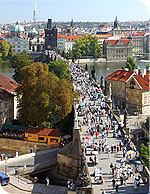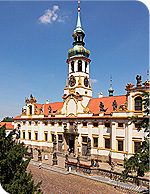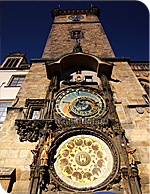|
|
| |
|
|
| |
| Tourist Information |
|
| Czech Republic in Brief |
|
 |
|
The Czech Republic is
a democratic, politically, economically and
socially stable country, situated in Central
Europe. With its area 78 864 km2 and
population 10.3 million, it belongs to middle-sized
European countries. It is rich in natural
beauties and cultural monuments, which is
confirmed by a list of the world cultural
and natural heritage UNESCO (see e.g. www.unesco-czech.cz),
including already 12 places from the whole
Czech Republic (Praha, Český Krumlov, Kroměříž,
Olomouc and other). This is also one of the
reasons why the Czech Republic is a sought-after
tourist destination. |
|
|
| Capital
city: |
|
Praha
(Prague) |
| Administrative
division: |
|
13
districts + Praha |
| Language: |
|
Czech |
| Currency: |
|
Czech
crown (Kč, CZK) = 100 halers |
| State
form: |
|
parliamentary
democracy, republic |
| President
of the republic: |
|
Václav
Klaus |
|
|
 |
|
| The Czech Republic
has been a member of the NATO since March 1999 and
a member of the European Union since May 2004.
In addition, it is a member of a lot of international
organizations: CERN, EBRD, IBRD, OECD, UN, IMF,
UNESCO, WHO, WTO and other. |
|
| Prague |
|


 |
|
The capital of the Czech
Republic, is our most valuable historical
city reserve. In 1992 the historical core
of the city covering 866 hectares was listed
in the UNESCO World Cultural and Natural Heritage
Register. |
|
|
| |
"Praga caput regni"
has been inscribed in Prague's coat of arms.
And rightly so. Since its beginning Prague
has always played an important role in the
history of the nation, and Europe. Since the
Middle Ages Prague has been known as one of
the most beautiful cities in the world, with
adjectives such as "golden", "hundred-spired",
"the crown of the world" and "a
stone dream". Throughout the centuries
prominent personalities paid homage to it.
W. A. Mozart, L. van Beethoven, G. Apollinaire,
P. I. Tchaikovsky, F. M. Dostoyevsky, A. Rodin,
O. Kokoschka, as well as the British Queen
Elizabeth II and Pope John Paul II all professed
their beguilement by its attractiveness and
architectural beauty. |
|
|
| |
The native town is reflected
in the works of Jan Neruda, Jaroslav Hašek,
Jaroslav Seifert, Franz Kafka, Max Brod or
Egon Erwin Kisch. Prague represents a unique
collection of historical monuments dominated
by the Prague Castle the which towers high
above the city. The city embraces all artistic
style and movements. The historical core of
the city is situated on both banks of the
Vltava river and consists of 6 districts –
formerly independent urban units unified in
the 18th century. They are as follows: Staré
Město (Old Town), Josefov (the preserved part
of the former Jewish Town – today a part of
Old Town), Nové Město (New Town), Malá Strana
(Lesser Town) Hradčany and Vyšehrad. Naturally
most of the historical monuments, museums
and galleries are concentrated in these places. |
|
|
 |
|
|
|
|
|
| |
|
|
|
|
|



